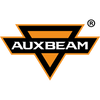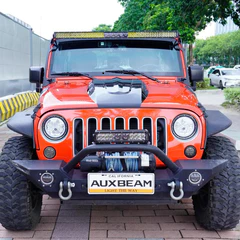
How to install the Auxbeam AC-1200 Switch Panel in a ’97-’06 Jeep TJ Wrangler?
Installing the Auxbeam AC-1200 switch panel involves a number of steps:
1. Mounting the control box
2. Powering the control box
3. Connecting the switch panel to the control box through the firewall
4. Mounting the switch panel in the cockpit
Mounting the Control Box
Supporting 12 circuits, the AC-1200 control box is fairly large. The best place for it in a TJ engine compartment is on the driver’s side inner fender. In the photo below, the mounting bracket supplied by Auxbeam is mounted, it’s just aft of the washer fluid reservoir and just outboard of the cruise control.

Mounting the bracket requires drilling one new hole. The photos below:
1. The bracket bolted in place just outboard of the cruise control (not all TJ’s have cruise control, but the mounting of the bracket is the same whether or not cruise control is present.
2. The left arrow points to an existing hole in the fender. The right arrow show the location of a new hole to be drilled.
3. (and 4) Since the inner fender isn’t a flat surface, a nylon spacer is added under the bracket on the side towards the rear of the Jeep. Nylon spacers can be found at most well-stocked hardware stores.
Once the second hole is located and drilled and a spacer and bolts of the proper length are on hand, the bracket can be bolted in place by running the bolts down through the fender and putting nuts on the underside of the fender. Putting washers between the nuts and the fender sheet metal is recommended.

Once the bracket is bolted in place on the inner fender, the control box can be bolted to the bracket.

Powering the Control Box
There are two power connections to the control box – switched power to operate the box, and higher current power to operate any accessories connected to the system.
Auxbeam supplies heavy-gauge cables to connect the control box to the Jeep’s battery to power accessories connected to the system. Unfortunately since the best place to install the control box is further away from the battery than the length of the supplied cables. Longer cables must be used, and they must be of a gauge heavy enough to carry the 100 amps of current that the control box is capable of supplying to accessories.
A good way to make new cables is to start with a set of jumper cables. Stores like Walmart offer relatively inexpensive jumper cables which are an excellent source of the require wire – this set offers 4-gauge wire and retails for less than $20: https://www.walmart.com/ip/Everstart-20-Foot-4-Gauge-Automotive-Booster-CablesJumper-Cables/182918724. Those cables are 20 feet long; only about 6 feet will be required to connect the control box to the battery so if you remove one of the clamps from the jumper cables, cut 6’ of wire from the 20’ and reinstall the clamps you will end up with a 14’ set of jumper cables and enough wire to connect the control box.
Also needed will be 4 ring terminals to terminate each end of the 6’ cables. Auto parts stores like AutoZone and many electrical supply stores offer ring terminals like those shown below – the accept 4-gauge wire and have a 3/8” I.D. ring which is perfect for connecting to the control box and the battery.

A completed cable to connect the control box to the battery made from part of a set of jumper cables can look like the one in the photo below. Red heat-shrink tubing has been added to one of the wires to indicate that it is the positive connection; black heat shrink tubing has also been shrunk over the ring terminals to protect them. The heat shrink tubing isn’t strictly necessary but it makes for a more professional looking cable. There’s a break in the positive side of the cable with terminals on each end of the break, that’s where the circuit breaker will be inserted into the circuit, as shown in the photo at right.

The other power connection required provides power to operate the system. It can go to the Jeep’s fuse panel and for switched power. Switched power is power that’s only active when the ignition switch is in the on/run position and is recommended so the system doesn’t draw power when the engine isn’t running, which might drain the battery. Or, it can go directly to the battery positive terminal and power to the system is controlled by a supplied switch.
Supplying Operating Power to the Control Box
The kit came with two fairly short wires for connecting power to the control box. One piece has a fuse adapter on it and the other piece has a plug for the control box. The fuse adapter makes it easy to supply switched power to the control box, but additional wire will be required in almost all installations to connect between these two pieces. Wiring option 1:

When I met with Auxbeam at the SEMA Show, they gave me an alternate wiring solution. This one has a ring terminal on one end for direct connection to the battery and an inline fuse, a plug on the other end for the control box, and a switch in the middle for turning power to the control box on or off. The wires are long enough for most installations. This solution might be better for a camping/overlanding vehicle in which accessories might need to be powered at the campsite when the vehicle isn’t running, but one must remember to turn the switch off if the system isn’t to be used when the engine isn’t running. Or, the ring terminal can be removed and that end of the wire can be connected to a switched circuit if the system isn’t to be used when the engine isn’t running. Wiring option 2:

Whichever wiring solution comes with your kit, both wiring solutions have their benefits and drawbacks but either one will work fine in most implementations.
Implementing wiring option 1:
In the TJ Wrangler, fuse position 14 powers the Jeeps radio and provides switched power. Auxbeam supplies a fuse adapter with the kit; remove the fuse from position 14 in the fuse panel (which is behind the glove box), plug the fuse adapter into that position and insert the fuse removed from position 14 into the open slot in the fuse adapter and shown in this photo:

Auxbeam provides a short length of red wire with a two-pin plug on one end, this plug goes into a two-pin location inside the control box. The other end of this red wire must connect to the loose end of the fuse adapter installed above, and two things are necessary to do this:
1. An extra length of red wire is required because the combination of the fuse adapter wire and the control box wire is too short to reach between them. Auto parts stores sell red 16-gauge wire for this purpose.
2. The additional wire must be run from the engine compartment into the cockpit where the fuse panel is. Also since the switch panel will also be installed in the cockpit, the cable that connects the switch panel to the control box must also be run from the engine compartment into the cockpit.
Implementing wiring option 2:
With the second wiring option, the ring terminal is connected to the positive terminal of the battery, and the wires that connect to the switch get routed through the firewall as will be described below; the switch can be mounted in any convenient place on or under the dash.
Or, if it is desired to have the system be connected to switched power, the ring terminal end of the wire can be routed into the cockpit, to the fuse panel behind the glove box and connected to a switch circuit using a fuse adapter as shown with the option 1 wiring.
Connecting the switch panel to the control box through the firewall
There are several places in the Wrangler firewall that wires can be passed through.
1. In a Wrangler with a manual transmission, a rubber plug can be found in the firewall at the driver’s side of the engine (arrow #1).
2. A Wrangler with an automatic transmission will not have a clutch cylinder (arrow #2). This photo is from a Wrangler with a manual transmission but if this were an automatic, a plastic block-off plate would be where the clutch cylinder is in this photo; a hole can be drilled through that plate to pass the wires. It’s best to remove the plate before drilling it just in case there’s something behind it that the drill might damage
3. Below the block-off plate or the clutch cylinder in all TJ’s is a wiring harness pass-through (arrow #3). There is enough space in the hole in the firewall that the wiring grommet goes in to allow additional wires through, so if neither of the above locations are best for your situation you could run the wires through this hole.

Installing the Switch Panel
Once the switched power wire in run into the cockpit to the fuse panel and connected and the switch panel cable is run into the cockpit, it’s time to decide where to mount the switch panel.
Having 12 oversize switch buttons, it’s a fairly large panel to find a place for within reach of the driver in a TJ.
Some people mount it on the trim panel below the instrument panel and steering wheel, but mounted there it can be hard to see and may be a distraction while driving, so that may not be the best location. (A switch panel in this location is shown on page 5 of the AC-1200 instructions) Two other locations that work in the TJ are shown in the photos below – it can be mounted to the windshield frame trim above the rear-view mirror, or it can be mounted just ahead of the shifter on the center console.

There are two other options for controlling accessories connected to the system…
One is to use the supplied remote control. In this next photo, the remote is sitting in a cell phone holder that’s mounted to the windshield of the TJ with a suction mount. The remote can turn any of the 12 circuits on or off, the only thing you don’t get with this option is the labels on the keys so you will have to remember what each button does. But an additional feature you do get is the ability to control the circuits remotely – say for example you’ve got campsite accessories connected to the Auxbeam system, you can turn them on or off while sitting at the campfire. Perhaps campsite lights attached to the roof rack of the Jeep?

The other option is to use the Auxbeam Switch Panel app from your Android device or iPhone. The app is active in this next photo; the top half of the screen shows the 12 keys and you can configure the keytops on the screen with the same labels you might have put on the physical switch panel. And you can control the system anywhere within range of the Bluetooth connection.


